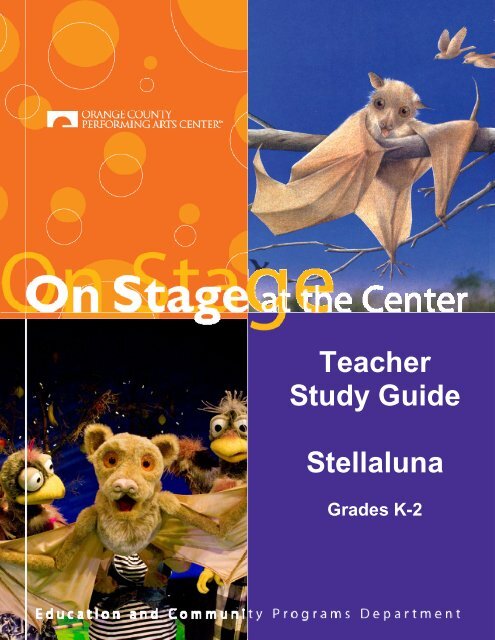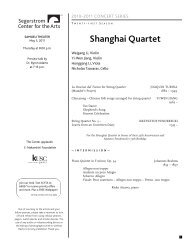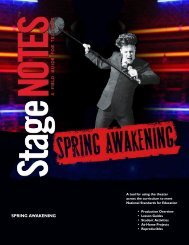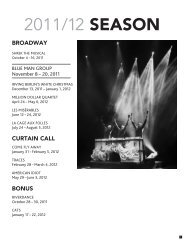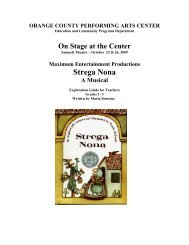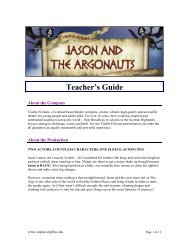Teacher Study Guide Stellaluna
Teacher Study Guide Stellaluna
Teacher Study Guide Stellaluna
Create successful ePaper yourself
Turn your PDF publications into a flip-book with our unique Google optimized e-Paper software.
<strong>Teacher</strong><br />
<strong>Study</strong> <strong>Guide</strong><br />
<strong>Stellaluna</strong><br />
Grades K-2<br />
www.OCPAC.org/bus-ins 1
ABOUT THE PERFORMANCE<br />
Everybody's favorite bat swoops in for the musical premiere of Janell Cannon's<br />
enormously popular book <strong>Stellaluna</strong>. Separated from her mother during a night of<br />
foraging, little <strong>Stellaluna</strong> lands in a bird's nest and is happily adopted by Mama Bird, but<br />
<strong>Stellaluna</strong> just can't shake her batty ways. The play is based on the book and is<br />
performed by 5 actors. The actors portray both human characters and puppet<br />
characters on stage. They sing, dance and play the piano. As puppeteers, the actors<br />
use their whole body to manipulate the puppets expressively. The audience sees the<br />
puppet and puppeteer together onstage.<br />
ABOUT THE AUTHOR<br />
"I love the science of this whole thing," Janell commented. "Anatomy and physiology,<br />
physics and how an animal is built, how they move, how they evolved. It's really fun!"<br />
Janell Cannon is the award-winning author and illustrator of picture books about<br />
unappreciated and fascinating creatures, including Crickwing, Verdi, and the beloved<br />
bestseller <strong>Stellaluna</strong>.<br />
A self-taught artist and writer, Janell Cannon has always admired animals, especially<br />
creatures that have been misunderstood or neglected. Her love of bats, spiders,<br />
Komodo dragons, and snakes inspired her work at a public library, where she<br />
developed award-winning summer reading programs about these unusual animals.<br />
While conducting research for a program about bats, Ms. Cannon found only two picture<br />
books on the subject, both of which were out of print. She decided it was time to make<br />
her own story about these wonderful creatures.<br />
Ms. Cannon created <strong>Stellaluna</strong> (1993) in hopes that she would transform young<br />
people's fear of bats into informed affection. "Fruit bats don't drink blood and won't get<br />
caught in your hair. I hope to show them in a positive light so they might be given more<br />
respect," she says.<br />
With <strong>Stellaluna</strong>, she also wanted to touch readers by exploring a friendship between two<br />
different kinds of creatures, a bat and baby birds. Ms. Cannon likens the book to "a<br />
mirror, so that anyone who looks into it will see their own way." She never suspected<br />
the book would become a runaway bestseller.<br />
Ms. Cannon writes and illustrates picture books full-time. Born and raised in Minnesota,<br />
she now lives in Southern California.<br />
--Harcourt<br />
www.OCPAC.org/bus-ins 2
PRE-SHOW ACTIVITIES<br />
Pre-Show Activity:<br />
<strong>Stellaluna</strong> Trivia Quiz<br />
Everyone wants to know about <strong>Stellaluna</strong> and her friends! Read <strong>Stellaluna</strong>, then answer<br />
the questions below and find out just how much you actually know about the beloved<br />
fruit bat. Check your answers by comparing them to the correct answers shown on the<br />
back of this sheet. (Note: Most answers can be found in the Bat Notes section in the<br />
back of <strong>Stellaluna</strong>.)<br />
Trivia Questions:<br />
1. Why couldn’t <strong>Stellaluna</strong> just fly away with her mother when the owl attacked<br />
2. What are the names of <strong>Stellaluna</strong>’s three bird friends<br />
3. Where do most fruit bats live<br />
4. Though <strong>Stellaluna</strong> is a fruit bat, what other animal does she closely resemble<br />
5. What is the scientific name for bats<br />
6. Are bats the only mammals capable of powered flight<br />
7. How does <strong>Stellaluna</strong> adapt to the habits of her new family, the birds<br />
8. Do all the winged creatures in <strong>Stellaluna</strong> eat fruit<br />
9. Who is the author and illustrator of <strong>Stellaluna</strong><br />
10. How many species of fruit bats are there<br />
Answers to <strong>Stellaluna</strong> Trivia Questions:<br />
1. <strong>Stellaluna</strong> couldn’t fly away because her wings were too weak.<br />
2. Pip, Flitter, and Flap.<br />
3. Most fruit bats live in tropical and subtropical climates that provide year-round<br />
reserves of fruit, flowers, and nectar.<br />
4. The fox.<br />
5. Chiroptera, which means “hand-wing.”<br />
6. Yes.<br />
7. She eats bugs; flies during the day and sleeps at night; and doesn’t hang by<br />
her feet.<br />
8. No; the birds eat bugs.<br />
9. Janell Cannon.<br />
10. About 170.<br />
www.OCPAC.org/bus-ins 3
Pre-Show Activity:<br />
Bat Myths<br />
Many myths and stories portray bats in a negative way. Read on to find out the truth<br />
about bats!<br />
Myth # 1:<br />
Fact:<br />
Myth # 2:<br />
Fact:<br />
Myth # 3:<br />
Fact:<br />
Myth # 4:<br />
Fact:<br />
Bats are scary creatures that turn into vampires.<br />
Sometimes people tell stories about vampires that can change into bats<br />
but vampires are not real. Bats are very gentle and do not want to bother<br />
humans.<br />
When bats fly around they are trying to bite people and will get<br />
tangled in your hair.<br />
Bats will not hurt you and they certainly will not get tangled in your hair!<br />
Their sharp senses prevent them from flying into people. For bats,<br />
humans are not that interesting; they would rather chase a bug or a find a<br />
squishy banana.<br />
Bats are flying rodents that carry diseases.<br />
Bats are not rodents. In fact, they are very clean and carry very few<br />
diseases. It is always a good idea to remember that bats are wild animals<br />
and should never be handled by humans.<br />
All bats are blind.<br />
Bats are not blind. They can see in the dark. The saying, “Blind as a bat,”<br />
is not accurate!<br />
www.OCPAC.org/bus-ins 4
ALL ABOUT BATS<br />
Bats are gentle, helpful and misunderstood creatures. Did you know that bats are<br />
mammals just like us except they are the ONLY mammals that can fly Did you know<br />
that bats live all over the Earth except in the Arctic and Antarctica There are almost<br />
1,000 species of bats in the world but here in the United States, the little brown bat is<br />
the most common. Some species of bats can live for up to 30 years. Have you ever<br />
wondered how a bat flies Or how they navigate at night Read on to learn all about<br />
bats.<br />
Two Groups of Bats:<br />
Bats are divided into two distinct groups: Microbats & Megabats.<br />
Microbats are small carnivorous bats. They live in locations all over the world but<br />
require hibernation or migration during the winter months. They have smaller eyes<br />
than Megabats. Microbats may hunt insects such as mosquitoes, moths, beetles or<br />
grasshoppers or they can eat fish scorpions, lizards, frogs or birds. Each night an<br />
insect-eating bat eats half its own weight in bugs. If you weigh 60 pounds, that is like<br />
eating 125 peanut-butter-and-jelly sandwiches every single day!<br />
Megabats are large herbivores that eat fruit, flowers, nectar or pollen. Most live in<br />
warm, tropical places. These have tiny ears since they rely on their eyes and nose to<br />
detect food. Fruit bats have large eyes and can see better than other bats. Most fruit<br />
bats eat figs, mangoes, bananas and nuts.<br />
How Bats Help People & the Environment<br />
Fruit bats are an integral part of cross-pollination and help our rainforests grow. When a<br />
fruit bat grabs fruit off the tree and eats it, the seeds drop to the ground and those seeds<br />
sprout into new plants. Or if a bat eats pollen from a flower, the pollen sticks to their fur<br />
and rubs off on the next flower.<br />
Insect bats help us by eating pesky insects that sting or bite people, spread diseases or<br />
destroy crops. Some bats eat about 600 insects per hour! They eat mosquitoes, gnats,<br />
midges and serious crop pests such as cucumber beetles, June bugs, stink bugs and<br />
leaf hoppers.<br />
Bats do not like pollution and cannot live near polluted water. If you see a bat in your<br />
neighborhood, that means you live around clean air and clean water!<br />
www.OCPAC.org/bus-ins 5
Bat Body Parts<br />
All bats have skeletons just like humans with arm,<br />
leg, hand and foot bones. They have light bones<br />
and small bodies which makes less weight to<br />
carry through the air. They do not have feathers<br />
but their bodies are covered in fur and they have<br />
short legs. Bat legs are so short, they rarely use<br />
them for walking but rather their tiny legs help<br />
support the weight of their wings when flying.<br />
Copyright © 1993 by Janell Cannon<br />
Bat’s wings are actually formed from their hands<br />
and long fingers spread out and connected with<br />
a thin skin. A leathery skin-like layer of thin skin<br />
called the patagium covers their hands and arms<br />
forming the wings. This skin is so thin that light can be seen through it. There is no flesh<br />
on the wing, just bones, nerves and blood vessels. The stretchy and rubbery skin of the<br />
wings is like a webbed hand that allows the bats to fly, swoop, soar, dart and dive. A bat<br />
bends its wings so well it can catch a flying insect in its wing and then scoops it into its<br />
mouth.<br />
Bats are nocturnal which means they are active at night. They fly at night because this<br />
is when they can find their favorite meals. Sometimes so many bats fly together it looks<br />
like a cloud of thick smoke. Some bats can fly as fast as 15 miles per hour. When they<br />
are flying, bats use their tails for balance and for sudden turns and changes of direction.<br />
Bats with tail membranes also use them as brakes.<br />
A bat’s thumb is on the edge of its wing. Their thumb is small and stumpy with a useful<br />
claw. Bats use these hooked thumb claws and the claws on their toes to hang upside<br />
down. The claws also help them move around, scoot up a tree trunk, walk across a<br />
cave wall, comb their fur and to clean their faces. Bats keep themselves very clean just<br />
like cats by using their claws and tongues. When they hang upside down, bats fold their<br />
wings around their bodies. This makes them look like tiny umbrellas neatly folded and<br />
closed with their wings wrapped tight around their bodies.<br />
Hunting/Hearing<br />
Bats navigate by using echolocation. Some bats use<br />
echolocation by screeching with their mouths and<br />
others send out waves through their noses. Most of<br />
their squeaks are too high for human ears to hear.<br />
Echolocation is the process of sending out waves of<br />
high pitched sounds. Once the sound wave is sent out,<br />
it hits an object and then bounces an echo back to the<br />
bat. The echo travels to the bat’s brain where the<br />
www.OCPAC.org/bus-ins 6
sounds form a picture of the animal’s surroundings. Echoes returning to the bat tell it<br />
several things: the location and size of objects and how fast insects and other prey are<br />
traveling. To tell how far away the object it, the bat keeps track of time between when it<br />
calls out and when the echo returns. If an object is nearby, the sound comes back<br />
quickly. If the object is farther away, it takes longer for the sound to travel back to the<br />
bat’s ear.<br />
The echoes that bounce off a tree sound different from the echoes off a bug. The<br />
echoes are so precise and accurate that a bat can tell the difference between the<br />
steady beating of a moth’s wings and the fluttering of leaves. As a bat travels above a<br />
field or other open area, it sends out one or two calls each second. In the woods, the<br />
bats call out about ten times per second. The “echoes” help the bats “see” the tree<br />
branches, rocks, ground and other objects that do not move. Echolocation allows bats<br />
to find and catch prey in as little as half a second.<br />
Remember, if a bat flies into your house, open a door or window. The bats will use<br />
echolocation to find the opening and fly out. Bats are not the only animals to use<br />
echolocation. Dolphins and whales also use echolocation as a way of navigating<br />
through the ocean.<br />
Bat homes are called roosts. Some bats are<br />
solitary and roost in trees. Most species of<br />
bats live in groups called colonies. Some<br />
colonies are made up of thousands or even<br />
millions of bats, and some only have a few<br />
bats. Colonies usually live in large caves,<br />
attics, barns, garages, trees old mines,<br />
tunnels or under bridges.<br />
Bat Habitats<br />
Bats hang upside down from perches or<br />
resting places high above the ground. Resting<br />
in high places keeps bats safe from predators<br />
like hawks, owls, snakes, skunks, cats, dogs<br />
and raccoons. Hanging upside down allows<br />
them to fly away quickly. To begin flying, bats<br />
let go of their perches and start flapping their<br />
wings. Most bats cannot take off from the ground.<br />
Copyright © 1993 by Janell Cannon<br />
Hibernation<br />
In the winter, many bats hibernate. During this time, they go into a very deep sleep.<br />
When they hibernate, their breathing slows down and their heart rate drops from 900 to<br />
20 beats a minute. They get ready for hibernating by stuffing themselves full of food<br />
during the last weeks of warm weather.<br />
www.OCPAC.org/bus-ins 7
Never disturb bats in caves while they are hibernating. Bats will most likely die if they<br />
are disturbed during their hibernation as they cannot find food during the winter. The<br />
small physical movement from one location in a cave to another location can deplete<br />
their stored body fat and cause them to starve to death.<br />
Migration<br />
Some bats stay in the same place all year long where it is always warm. These bats do<br />
not hibernate or migrate because they have everything they need just where they are.<br />
Other bats migrate before the weather gets cold and fly to warmer places. They stay<br />
where it is warm until the weather starts to change and then they head to their old<br />
roosts. Some migrations span over hundreds of miles.<br />
Reproduction<br />
Most mother bats only have one baby per year and usually give birth in June. A baby<br />
bat is called a pup and many bat pups hang together in large groups called nurseries. A<br />
single nursery can hold over one million bats! Some pups are born with pink skin and no<br />
hair. Their eyes are closed at birth. Other pups are born with fur and these pups start<br />
life with their eyes open. Each baby bat has its own special chirp and smell. Every<br />
mother knows and can find their baby by this specific sound and smell! Bats are the<br />
only flying animals that nurse. Each mother feeds their pups at least twice a night. After<br />
each feeding, the mother leaves the nursery to find her own food. Female bats with no<br />
babies often join a nursery and help other bats’ babies survive.<br />
www.OCPAC.org/bus-ins 8
POST-SHOW ACTIVITIES<br />
Animal Research<br />
Animals inhabit different kinds of environments and have external features that help<br />
them thrive in different places. Think of an animal that is thought of negatively like a<br />
scorpion or a mosquito. Research your animal at the library. Draw a picture of your<br />
animal labeling each body part. Present your animal to your class; try to change<br />
people’s fears about the animal so they understand why your animal is the way it is.<br />
Experience Echolocation<br />
(Requires Adult Supervision for Safety)<br />
Microbats hunt insects such as mosquitoes, moths, beetles or grasshoppers or they<br />
hunt fish scorpions, lizards, frogs or birds by using echolocation. Your students can<br />
simulate echolocation in the classroom and practice “seeing” with sound.<br />
Ask three students to be trees. The trees sit on chairs 6 feet apart and cannot move so<br />
the bat and insect can go between them. Ask three students to be insects. Insects can<br />
move one step in any direction after responding to the bat’s call. One blindfolded<br />
student plays the bat. The bat points his arms in the direction he sends out his echo and<br />
says, “Beep.” If a tree or insect is in their path, the tree says, “Tree,” and the insect says,<br />
“Insect.” Insects are caught when they are tagged by the bat. If the bat runs into a tree,<br />
the hunt is over.<br />
Rewrite the Story<br />
As a class, divide the story of <strong>Stellaluna</strong> into scenes on the chalkboard. Number the<br />
scenes in sequential order. Remove an ending scene and ask the students to rewrite<br />
the story with their own new ending. Try the exercise again and list all the characters in<br />
the story on the chalkboard. Remove one character and ask the students to rewrite the<br />
story incorporating a new character.<br />
Theater Critic Exercise<br />
How did the actors portray each character How did the actors interact with the set Did<br />
any parts of the set transform during the performance Create your own puppets and<br />
ask each student to show how they would perform and manipulate a puppet in the story.<br />
Delicious Art!<br />
Bats can be divided into groups based on their diet. A fruit bat would not like to eat an<br />
insect and an insect bat would not like to eat a mango! Pretend you are a chef planning<br />
a delicious meal for bats. Illustrate a menu for your bat friends. Make sure you include<br />
an herbivore and a carnivore section. Herbivore menu items can include: flowers,<br />
mangoes, dates, figs, cashews, peaches, bananas, papayas, avocadoes or guavas.<br />
Carnivore menu items can include: mosquitoes, moths, beetles, grasshoppers, fish,<br />
scorpions, lizards, frogs or birds. Think of fun names for your dishes or combine foods<br />
to make new dishes for your bat friends. Draw an example of a carnivorous and<br />
herbivorous bat in each menu section.<br />
www.OCPAC.org/bus-ins 9
Bat Labeling<br />
Try to identify and label these body parts: eye, ear, arms, thumb, second finger, third<br />
finger, fourth finger, fifth finger, elbow, tail, toes, leg, fur and wing membrane.<br />
www.OCPAC.org/bus-ins 10
www.OCPAC.org/bus-ins 11
EXTRAS<br />
Appendix: Kinds of Bats<br />
California Leaf-Nosed Bats: These bats live in lowland desert areas of the<br />
western U.S. & Mexico. Instead of using echolocation, these bats find bugs by<br />
listening for their footsteps or wing beats. Then they pluck the moth or mosquito from<br />
the ground or plant. They can even hear a cricket walking!<br />
Fishing Bats: From Central & South America, these bats catch fish and can eat<br />
up to 40 small fish in one night. The Fishing Bat flies above the surface of the rivers<br />
and lakes and directs its echolocation toward the water. From the echoes, the bat<br />
can sense the ripples in the water and knows that a fish is swimming near the<br />
surface. It drops its feet in the water and scoops up the fish with its big sharp claws<br />
and eats the fish! These bats sometimes fall into the water but they can swim and<br />
use their wings as oars to swim to safety.<br />
Flying Foxes: These bats are giants in the bat world, with wingspans of up to six<br />
feet. They weigh almost two pounds. They live in warm, tropical areas and usually<br />
roost in treetops. They eat fruit, nectar, flowers and pollen but prefer ripe, squishy<br />
fruit. Australia’s grey-headed flying fox feeds on the fruit of gum, eucalyptus and fig<br />
trees. Without these and other fruit bats to spread seeds and pollen, many tropical<br />
and subtropical forests around the world might not survive.<br />
Gray Bats: These insect bats are endangered. They can catch and eat as many<br />
as 3,000 insects each night! They can hibernate in only nine caves in the U.S.,<br />
where the temperature stays the same all winter. In the summer, you may be able to<br />
see gray bats at Nickajack Cave, near Chattanooga, TN; Rockbridge Memorial State<br />
Park, near Columbia MO; and Blowing Wind Cave, near Scottsboro, AL.<br />
Greater Short-Nosed Bat: A fruit bat that feeds on the pollen of wild banana<br />
plants. Without these bats, the banana plants would die out from lack of crosspollination.<br />
The bats and plants really need each other!<br />
Hog-Nosed Bats: These insect bats from Thailand are the tiniest bats and the<br />
world’s smallest mammals. About the size of bumblebees, they weigh less than a<br />
dime and have a wingspan of just five and a half inches.<br />
Vampire Bats: These bats live in parts of Mexico, Central and South America.<br />
They are the only species of bats that eat blood. Most often they feed on the blood<br />
of sleeping cattle or other livestock. With its sharp teeth, it makes a tiny cut in the<br />
animal’s skin usually near the hoof. The cow or horse doesn’t feel anything and<br />
usually doesn’t wake up.<br />
www.OCPAC.org/bus-ins 12
SOURCES<br />
Berger, Melvi & Gilda. Screech! A Book about Bats! New York: Scholastic, 2000.<br />
Earle, Ann. Zipping, Zapping, Zooming Bats. New York: HarperCollins, 1995.<br />
Glaser, Linda. Beautiful Bats. Connecticut: The Millbrook Press, 1997.<br />
Greenaway, Frank. Amazing Bats. New York: Alfred A. Knopf, 1991.<br />
Kalman, Bobbie & Lundblad, Kristina. Endangered Bats. New York: Crabtree Publishing<br />
Company, 2006.<br />
Milton, Joyce. Bats: Creatures of the Night. New York: Grosset & Dunlap, 1993.<br />
Penny, Malcolm. How Bats “See” in the Dark. New York: Marshall Cavendish, 1997.<br />
Simon, Seymour. Amazing Bats. San Francisco: SeaStar Books, 2005.<br />
Stewart, Melissa. How Do Bats Fly in the Dark New York: Marshall Cavendish, 2009.<br />
Bat Conservation International:<br />
Harcourt Trade Publishers:<br />
http://www.harcourtbooks.com/AuthorInterviews/bookinterview_Cannon.asp<br />
Teaching Pre-K-8:<br />
http://www.teachingk-<br />
8.com/archives/author_interview/janell_cannon_mysteries_of_the_misunderstood_by_k<br />
atherine_pierpont_senior_editor.html<br />
www.OCPAC.org/bus-ins 13


